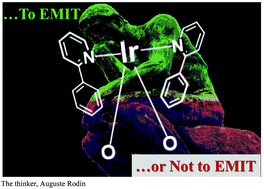β-Diketonate ancillary ligands in heteroleptic iridium complexes: a balance between synthetic advantages and photophysical troubles†
Abstract
β-Diketones are an important class of bidentate cyclometalating compounds, used in organometallic chemistry as ancillary ligands because of their wide commercial availability and easy synthesis. They are employed to finely tune the electronic, spectroscopic and physical properties of metal complexes. Heteroleptic iridium complexes often benefit from the use of β-diketonate ligands, their properties being similar to those of the corresponding homoleptic tris-cyclometalated ones. Nevertheless, in some cases, their use results in a complete quenching of the phosphorescence. Aiming to understand the origin of this drawback, we designed a suitable class of heteroleptic complexes and studied their thermal stability (DSC/TGA). We explored the effect of the ancillary ligand in a series of Ir(III) complexes bearing 2-phenylpyridine (ppy) as a cyclometalated ligand and acac (acetylacetonate), tta (2-thienoyltrifluoroacetonate), dtdk (1,3-di(thiophen-2-yl)propane-1,3-dionate) and BPhen (4,7-diphenyl-1,10-phenanthroline) as ancillary ligands. Through photochemical and electrochemical investigations, whose results agree with and support our density functional theory calculations, we demonstrate that β-diketonate ligands with low triplet energy generate dark triplet excited states with negligible coupling to the ground state which indeed promote non-radiative relaxation through population of higher states.

- This article is part of the themed collection: 28th International Conference on Photochemistry (ICP 2017)


 Please wait while we load your content...
Please wait while we load your content...